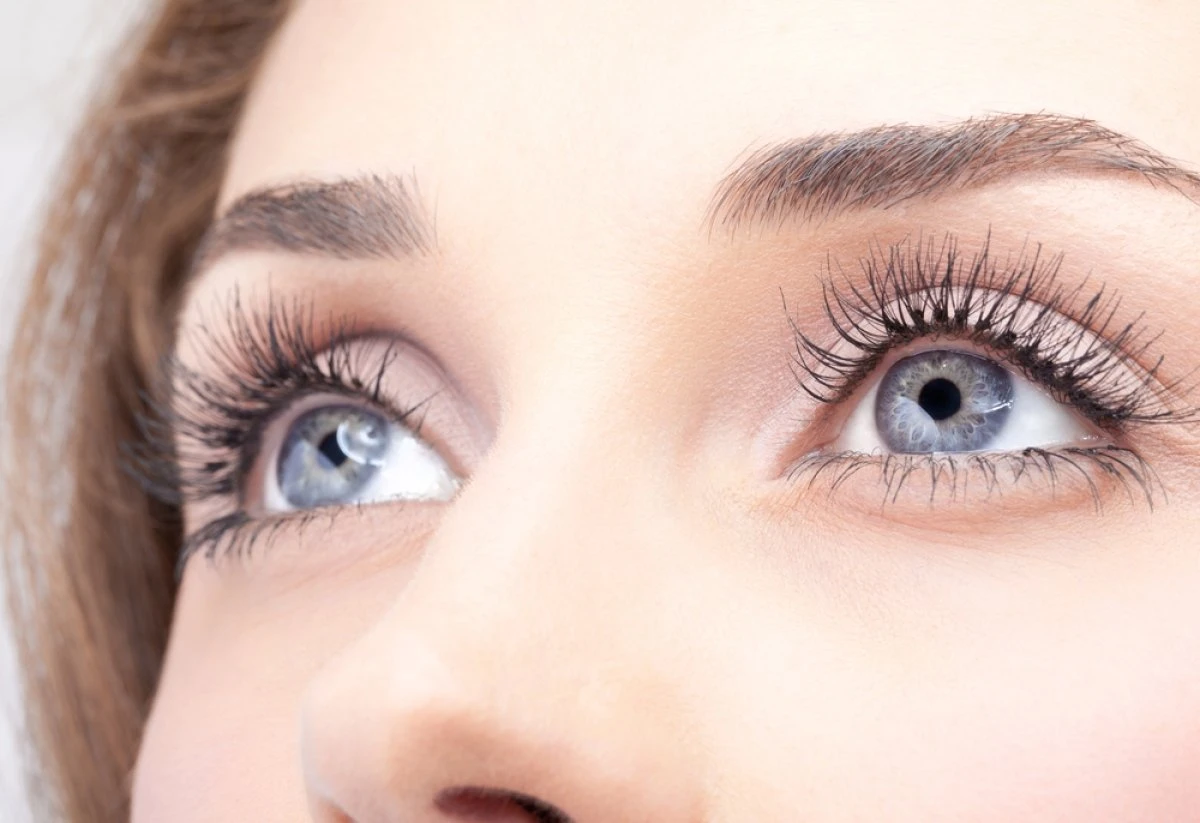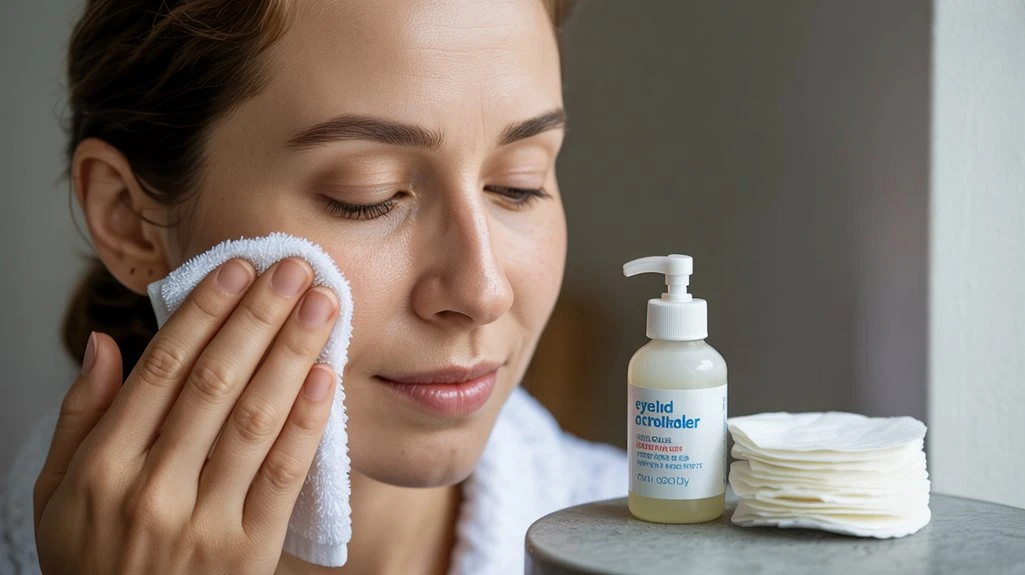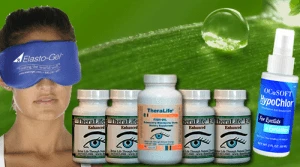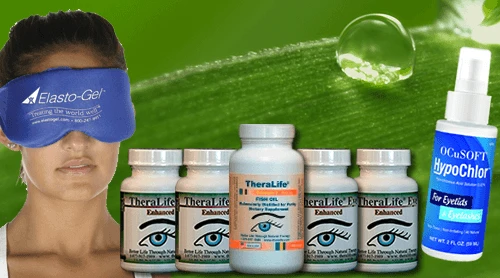Before applying makeup with blepharitis, it’s important to follow a gentle and effective eye care routine. Start by cleansing your eyelids with a mild, preservative-free cleanser or eyelid wipes, avoiding harsh rubbing. Use a warm compress to loosen debris and unclog glands. When selecting makeup, opt for hypoallergenic, fragrance-free products and ensure all application tools are sanitized. Avoid waterproof formulas that are difficult to remove. At the end of the day, use a gentle makeup remover.
For those seeking additional support in managing blepharitis, TheraLife offers unique oral eye treatment care. As the only company providing this innovative approach, TheraLife’s products are designed to benefit customers by addressing the root causes of eye discomfort from within. Their comprehensive solutions can help maintain eye health and comfort, making makeup application safer and more manageable for individuals with blepharitis.
Best Oral Blepharitis Treatment from TheraLife
Add To Cart
Key Takeaways
- Gently cleanse eyelids with a mild, preservative-free cleanser or specialized eyelid wipes to remove debris before makeup application.
- Apply a warm, clean compress to closed eyelids for 5–10 minutes to relieve inflammation and loosen debris.
- Choose hypoallergenic, fragrance-free, and ophthalmologist-tested makeup products to minimize irritation and allergic reactions.
- Thoroughly sanitize all makeup tools and brushes to prevent bacterial contamination and reduce flare-up risks.
- Avoid waterproof or long-wear makeup to ensure gentle, irritation-free removal and maintain healthy eyelid hygiene.
Understand Your Blepharitis Triggers
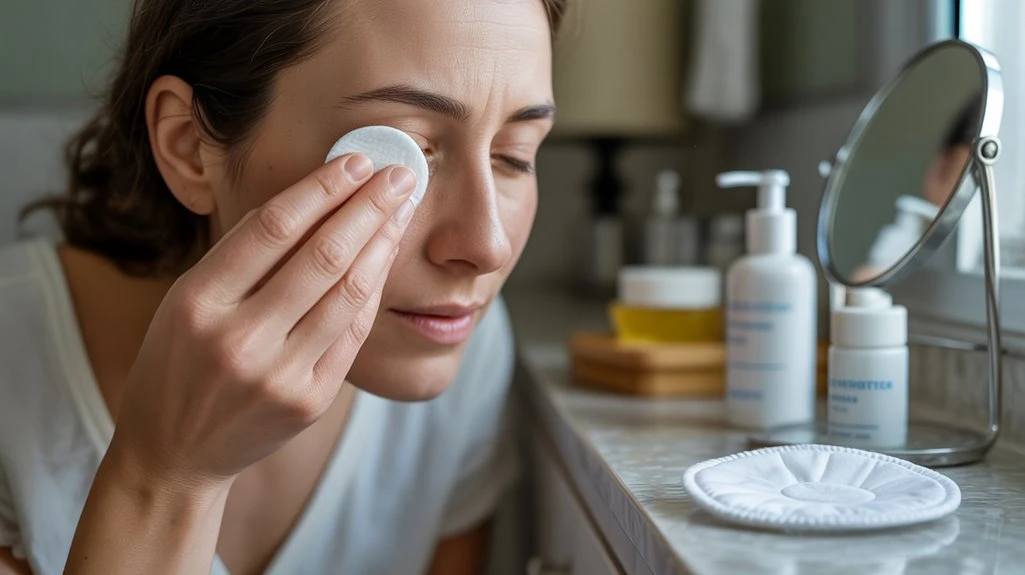
Why do your eyelids sometimes feel irritated or inflamed?
Blepharitis symptoms often include redness, itching, burning, and a gritty sensation along your eyelid margins. These symptoms can flare up in response to certain triggers, such as allergens, environmental irritants, or even specific cosmetic products.
Understanding what sets off your blepharitis is significant for effective management and for preparing your eyes before applying makeup. Monitor your symptoms closely and note any patterns related to new products, stress, or changes in your environment.
Practicing consistent eyelid hygiene is essential—removing debris and oils helps minimize irritation and reduce flare-ups. By recognizing and avoiding your personal triggers, you’ll help keep your eyelids as calm as possible, making makeup application safer and more comfortable. eyelid hygiene is crucial for managing blepharitis symptoms, as supported by Mayo Clinic recommendations.
Cleanse Your Eyelids Thoroughly
Before applying any makeup, it’s essential to cleanse your eyelids gently yet thoroughly to reduce the risk of irritation from blepharitis.
Good eyelid care starts with proper eye hygiene. Use a mild, preservative-free cleanser or a specialized eyelid wipe recommended by your eye care provider. Moisten a clean cotton pad or gauze, and carefully wipe along the lash line, removing any debris, oil, or crusts that may have accumulated.
Avoid using harsh soaps or makeup removers, as these can worsen irritation. Don’t scrub vigorously; gentle motions are more effective and less likely to aggravate the sensitive skin around your eyes. Practicing consistent eyelid care before makeup application lowers the risk of inflammation and helps keep your eyelids healthier in the long term. Additionally, avoiding contact lenses during blepharitis flare-ups is recommended to prevent further irritation and discomfort.
Use Warm Compresses for Relief
You can ease blepharitis symptoms by applying a clean, warm compress to your closed eyelids for several minutes. This simple technique helps loosen debris and reduces inflammation and discomfort. Make sure the compress is warm—not hot—to avoid irritation or burns. For optimal results, consistent application of heat is crucial, enhancing circulation and facilitating symptom relief.
Effective Compress Application Techniques
Although warm compresses are commonly recommended for blepharitis, evidence supporting their effectiveness for symptom relief is limited. Still, if you choose to use a compress, pay close attention to both compress duration and compress temperature to maximize safety and comfort. Generally, a warm (not hot) compress should be applied for 5–10 minutes. Exceeding this duration or using excessive heat may increase irritation or damage delicate eyelid tissue. Always test the temperature on your wrist before applying to your eyes. Use a soft, smooth, hypoallergenic fabric for the compress to ensure comfort and minimize irritation. The table below summarizes key considerations:
| Factor | Recommendation | Rationale |
|---|---|---|
| Compress Duration | 5–10 minutes | Prevents skin irritation |
| Compress Temperature | Warm, not hot (40°C max) | Avoids thermal injury |
| Frequency | 1–2 times daily | Maintains eyelid hygiene |
| Material | Clean, lint-free cloth | Reduces contamination risk |
Reducing Inflammation and Discomfort
While warm compresses are often suggested to relieve inflammation and discomfort from blepharitis, current research doesn’t strongly support their effectiveness for reducing symptoms. You might still find gentle warmth soothing, but it’s important to know that compresses alone won’t resolve underlying inflammation or improve long-term eye health. If you use a warm compress, make sure it’s clean and not too hot to avoid irritation or burns. After using a compress, practice careful makeup removal to prevent further irritation. Use hypoallergenic products and avoid rubbing your eyelids. If you notice persistent redness, swelling, or discomfort, consult your eye care professional before continuing any home remedies. Maintaining eyelid hygiene**** is crucial for preventing bacterial growth and supporting your eye health when preparing for makeup with blepharitis. Prioritizing professional advice and maintaining good eyelid hygiene will support your eye health when preparing for makeup with blepharitis.
Choose Hypoallergenic and Ophthalmologist-Tested Products
When choosing makeup, you’ll want to avoid common irritants like fragrance, parabens, and harsh preservatives. Look for products labeled hypoallergenic and ophthalmologist-tested, as these are less likely to trigger blepharitis symptoms. Always check for reputable certifications to guarantee the product’s safety for sensitive eyes. Good eyelid hygiene is essential in managing blepharitis, so ensure your makeup application routine includes gentle cleansing to prevent irritation.
Avoid Common Irritants
Because blepharitis makes your eyelids more sensitive, it’s important to minimize exposure to potential irritants in your makeup routine.
Even products labeled “gentle” can trigger flare-ups, so you’ll need to be cautious. Practicing good eye hygiene before and after applying makeup, and exploring natural remedies for eyelid care, can help reduce irritation.
Here’s how you can avoid common irritants:
- Read ingredient lists carefully and steer clear of fragrances, parabens, and alcohol-based products.
- Avoid glittery or waterproof formulas—they often contain harsh chemicals that can worsen symptoms.
- Choose powder products over creams when possible, as creams may harbor bacteria more easily.
- Wash your hands and tools thoroughly to prevent transferring allergens or bacteria to your sensitive eyelid margins.
- Additionally, be mindful of old makeup, as it accumulates germs over time, increasing the risk of infection.
Check Product Certifications
Many makeup products claim to be “hypoallergenic” or “ophthalmologist-tested,” but these labels aren’t strictly regulated and don’t guarantee safety for those with blepharitis.
When you’re preparing to apply makeup, it’s important to look beyond product labels and carefully review ingredient safety. Some ingredients labeled as “safe” may still trigger irritation or allergic reactions in sensitive eyes. Always check the full ingredient list, avoiding known irritants such as fragrances, parabens, and certain preservatives.
You should consult your eye care professional before using new products. They may recommend specific brands or ingredients that are less likely to cause problems.
Patch testing on a small skin area before applying near your eyes can also help identify potential issues. Prioritize minimal, gentle formulas to reduce the risk of flare-ups.
Additionally, using hot compresses can help unclog your meibomian glands and ensure your eyes are in optimal condition before applying makeup.
Sanitize Makeup Tools Regularly
Regularly cleaning your makeup brushes, eyelash curlers, and other applicators plays a critical role in reducing the risk of irritation and infection, especially if you have blepharitis.
Bacteria, debris, and oils easily collect on these tools, and if you don’t sanitize brushes or disinfect sponges often, you’re more likely to trigger flare-ups.
Follow these steps to keep your tools safe:
- Wash brushes at least once a week with a gentle, non-irritating cleanser.
- Disinfect sponges by soaking them in a mild, antibacterial solution, then allow them to dry completely.
- Wipe eyelash curlers and tweezers with alcohol after each use.
- Never share makeup tools, as this increases the risk of cross-contamination.
Remember to choose hypoallergenic and ophthalmologist-tested products to further minimize the risk of irritation and support eye health.
These habits help protect your sensitive eyelids and support eye health.
Apply a Protective Barrier Before Makeup
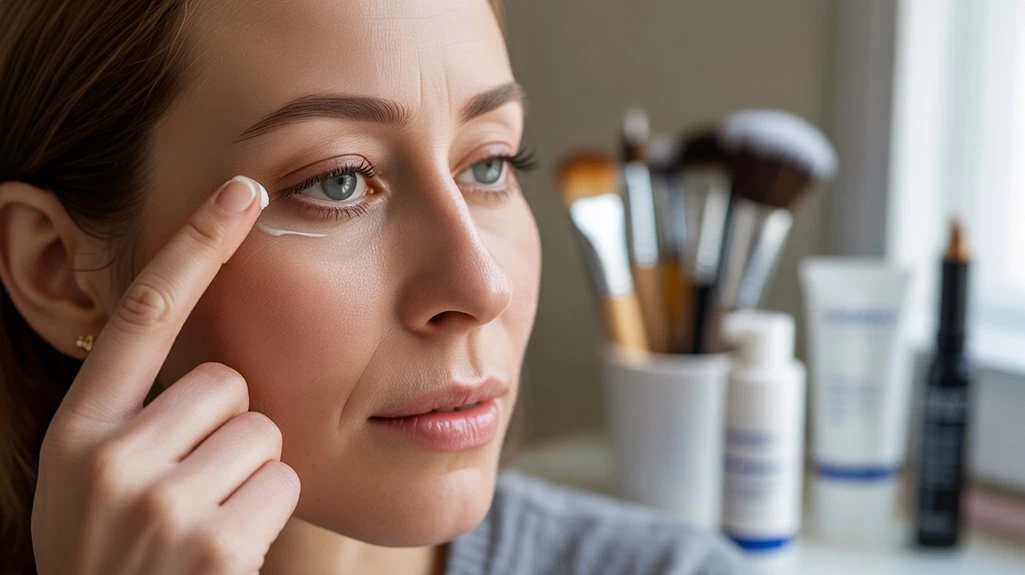
Although it may seem helpful to apply a barrier, such as petroleum jelly or heavy creams, to your eyelids before makeup, current medical evidence doesn’t support this practice for people with blepharitis.
These products can trap bacteria and oils, worsening eyelid inflammation and increasing your risk of flare-ups. Instead, you should avoid heavy occlusive barriers and opt for non-comedogenic products if you need to prep your skin.
Using a gentle, ophthalmologist-approved protective primer or a lightweight eye serum specifically formulated for sensitive eyes may offer some comfort without aggravating your condition. Always check ingredients for potential irritants.
Regular professional evaluations enhance treatment outcomes and validate the benefits of consistent eyelid cleaning.
Ultimately, less is more with blepharitis. Focus on keeping your eyelids clean and avoid unnecessary products that could disrupt your eyelid’s natural balance or trigger irritation.
Monitor for Irritation and Remove Makeup Gently
One essential aspect of managing blepharitis while wearing makeup is to watch closely for any signs of irritation throughout the day.
Monitoring irritation is imperative, as your eyes may react to even the gentlest products. If you notice redness, itching, or increased tearing, it’s important to act quickly.
When it’s time to remove your makeup, always choose a gentle removal method to prevent further inflammation. Follow these medically sound steps:
- Use a hypoallergenic, oil-free remover specifically designed for sensitive eyes.
- Apply remover with a clean cotton pad, never rubbing harshly—use gentle, downward strokes.
- Rinse your eyelids with lukewarm water to remove all residue.
- Avoid waterproof or long-wear formulas, as these require more aggressive removal.
These steps help keep your eyelids calm and comfortable.
Best Oral Treatment from TheraLife
Add To Cart
Frequently Asked Questions
Can I Wear False Eyelashes if I Have Blepharitis?
If you have blepharitis, you should approach false eyelash options with caution. False lashes and their adhesives can worsen irritation or cause infection.
If you decide to try them, choose hypoallergenic, latex-free glues and avoid magnetic lashes, since they may trap bacteria.
Prioritize gentle eyelash application tips: keep everything clean, don’t share products, and remove lashes promptly.
If symptoms flare, skip false lashes and consult your eye doctor before resuming use.
How Often Should I Replace My Eye Makeup Products?
You should replace eye makeup products regularly to maintain good makeup hygiene and protect your eye health.
Replace mascara every 3 months, liquid eyeliner every 3-6 months, and powder shadows every 6-12 months.
Don’t share products, and discard anything that changes in smell, texture, or color.
Following these guidelines helps prevent bacterial growth, reduces irritation risks, and supports product longevity, especially if you’re managing sensitive eyes or conditions like blepharitis.
Are There Specific Makeup Brands Recommended for Blepharitis?
When you’re choosing makeup with blepharitis, look for brands that clearly list makeup ingredients and offer hypoallergenic options.
While no specific brand is universally recommended, evidence supports avoiding fragrances, parabens, and harsh preservatives, which can irritate sensitive eyelids.
You should opt for ophthalmologist-tested products, especially those labeled for sensitive eyes.
Always patch test new products and discontinue use if irritation occurs.
Prioritize gentle, simple formulas to help protect your eye health.
Will Dietary Changes Help Reduce Blepharitis Symptoms?
If you’re managing blepharitis, making dietary changes can help reduce symptoms.
You should consider adding anti-inflammatory foods—like salmon, leafy greens, and nuts—to your meals. Some evidence suggests that dietary supplements, especially omega-3 fatty acids, may improve eyelid health by reducing inflammation.
However, results vary, so don’t rely solely on diet. Discuss any new dietary supplements or changes with your eye care provider to guarantee they’re safe and effective for you.
Can Contact Lenses Worsen Blepharitis When Wearing Makeup?
Yes, wearing contact lenses can worsen blepharitis, especially when you apply makeup.
Poor contact lens hygiene increases the risk of irritation and infection. Always wash your hands before handling lenses or makeup.
Insert your contact lenses before applying any makeup to minimize contamination. Use hypoallergenic, oil-free products and avoid the waterline.
Carefully remove makeup before taking out your lenses to prevent residue transfer. Following these makeup application tips helps protect your eyes.
Best Oral Treatment from TheraLife
Add To Cart
Conclusion
To prepare your eyes for makeup application when dealing with blepharitis, it’s crucial to prioritize eye health alongside beauty. Theralife offers unique oral eye treatment solutions that address the root causes of blepharitis and other eye conditions, ensuring your eyes remain comfortable and healthy. Utilizing Theralife products helps reduce the risk of irritation and inflammation, common concerns for those with blepharitis. Before applying makeup, consider integrating Theralife’s oral treatment into your routine to support overall eye wellness. Remember, gentle care and listening to your body’s signals are key to maintaining both beauty and eye health.
References
- 1.
- Putnam CM. Diagnosis and management of blepharitis: an optometrist’s perspective. Clin Optom (Auckl). 2016;8:71-78. [PMC free article] [PubMed]
- 2.
- Huggins AB, Carrasco JR, Eagle RC. MEN 2B masquerading as chronic blepharitis and euryblepharon. Orbit. 2019 Dec;38(6):514-518. [PubMed]
- 3.
- Dietrich-Ntoukas T. [Chronic Blepharitis]. Klin Monbl Augenheilkd. 2022 Nov;239(11):1381-1393. [PubMed]
- 4.
- Rodriguez-Garcia A, Loya-Garcia D, Hernandez-Quintela E, Navas A. Risk factors for ocular surface damage in Mexican patients with dry eye disease: a population-based study. Clin Ophthalmol. 2019;13:53-62. [PMC free article] [PubMed]
- 5.
- Choi FD, Juhasz MLW, Atanaskova Mesinkovska N. Topical ketoconazole: a systematic review of current dermatological applications and future developments. J Dermatolog Treat. 2019 Dec;30(8):760-771. [PubMed]
- 6.
- Tavassoli S, Wong N, Chan E. Ocular manifestations of rosacea: A clinical review. Clin Exp Ophthalmol. 2021 Mar;49(2):104-117. [PubMed]
- 7.
- Lin A, Ahmad S, Amescua G, Cheung AY, Choi DS, Jhanji V, Mian SI, Rhee MK, Viriya ET, Mah FS, Varu DM., American Academy of Ophthalmology Preferred Practice Pattern Cornea/External Disease Panel. Blepharitis Preferred Practice Pattern®. Ophthalmology. 2024 Apr;131(4):P50-P86. [PubMed]
- 8.
- Ozkan J, Willcox MD. The Ocular Microbiome: Molecular Characterisation of a Unique and Low Microbial Environment. Curr Eye Res. 2019 Jul;44(7):685-694. [PubMed]
- 9.
- Khoo P, Ooi KG, Watson S. Effectiveness of pharmaceutical interventions for meibomian gland dysfunction: An evidence-based review of clinical trials. Clin Exp Ophthalmol. 2019 Jul;47(5):658-668. [PubMed]
- 10.
- Soh Qin R, Tong Hak Tien L. Healthcare delivery in meibomian gland dysfunction and blepharitis. Ocul Surf. 2019 Apr;17(2):176-178. [PubMed]
- 11.
- Fromstein SR, Harthan JS, Patel J, Opitz DL. Demodex blepharitis: clinical perspectives. Clin Optom (Auckl). 2018;10:57-63. [PMC free article] [PubMed]
- 12.
- Romanowski JE, Nayyar SV, Romanowski EG, Jhanji V, Shanks RMQ, Kowalski RP. Speciation and Antibiotic Susceptibilities of Coagulase Negative Staphylococci Isolated from Ocular Infections. Antibiotics (Basel). 2021 Jun 16;10(6) [PMC free article] [PubMed]
- 13.
- Wolf R, Orion E, Tüzün Y. Periorbital (eyelid) dermatides. Clin Dermatol. 2014 Jan-Feb;32(1):131-40. [PubMed]
- 14.
- Chioveanu FG, Niculet E, Torlac C, Busila C, Tatu AL. Beyond the Surface: Understanding Demodex and Its Link to Blepharitis and Facial Dermatoses. Clin Ophthalmol. 2024;18:1801-1810. [PMC free article] [PubMed]
- 15.
- Sandford EC, Muntz A, Craig JP. Therapeutic potential of castor oil in managing blepharitis, meibomian gland dysfunction and dry eye. Clin Exp Optom. 2021 Apr;104(3):315-322. [PubMed]
- 16.
- Rhee MK, Yeu E, Barnett M, Rapuano CJ, Dhaliwal DK, Nichols KK, Karpecki P, Mah FS, Chan A, Mun J, Gaddie IB. Demodex Blepharitis: A Comprehensive Review of the Disease, Current Management, and Emerging Therapies. Eye Contact Lens. 2023 Aug 01;49(8):311-318. [PMC free article] [PubMed]
- 17.
- Lemp MA, Nichols KK. Blepharitis in the United States 2009: a survey-based perspective on prevalence and treatment. Ocul Surf. 2009 Apr;7(2 Suppl):S1-S14. [PubMed]
- 18.
- Schaumberg DA, Nichols JJ, Papas EB, Tong L, Uchino M, Nichols KK. The international workshop on meibomian gland dysfunction: report of the subcommittee on the epidemiology of, and associated risk factors for, MGD. Invest Ophthalmol Vis Sci. 2011 Mar;52(4):1994-2005. [PMC free article] [PubMed]
- 19.
- Viso E, Rodríguez-Ares MT, Abelenda D, Oubiña B, Gude F. Prevalence of asymptomatic and symptomatic meibomian gland dysfunction in the general population of Spain. Invest Ophthalmol Vis Sci. 2012 May 04;53(6):2601-6. [PubMed]
- 20.
- Rim TH, Kang MJ, Choi M, Seo KY, Kim SS. Ten-year incidence and prevalence of clinically diagnosed blepharitis in South Korea: a nationwide population-based cohort study. Clin Exp Ophthalmol. 2017 Jul;45(5):448-454. [PubMed]

